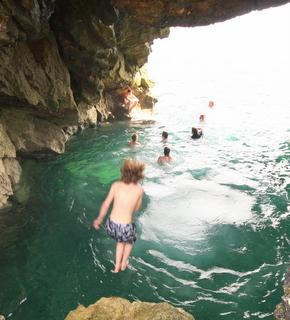
One of Britain’s fastest-growing adventure sports, coasteering is a mixture of swimming and exploring along the edge of the water, including climbing into caves, playing in the swell and jumping into pools.
If you want to try some simple coasteering yourself then the Wild Swimming Coast book will give you plenty of inspiration, but don’t attempt it at rocky and very exposed locations unless the sea is really calm. You need to be a strong swimmer, confident when clambering about over rocks, and understand the basics of tidal flows (particularly if you are outside the protection of a cove or bay: see p.254). You’ll need adequate footwear, such as trainers, and a wetsuit if you plan to be in for more than 15–20 minutes. Make sure you know how to get off the foreshore and on to the land if you get into difficulty, and how to summon help quickly.
Learn to deal with swell and rocks by building up your skills and confidence first in calm seas and sheltered areas. Once in the water, assume a squat or armchair position with your feet out in front as the main form of defence, and your hands ready to push off the rocks. As you approach your exit rock, work with the moving swell, riding it up and down, letting it launch you up to your chosen rock-hold but letting go and dropping back down again if you fail to get a strong enough hand-hold. Never haul yourself out on to rocks on your stomach – you’ll only be dragged back down and suffer grazes. Remember that swell is intermittent so wait for a lull and beware of large ferries and tankers, which can create a large wake even at a mile’s distance.
Exploring sea caves and swimming through them is a magical experience but even a light swell can suddenly strengthen as a cave narrows. Sudden high swell can also dump you on the rocks below, or knock your head against the ceiling. Take particular care if waves start breaking on the rocks.
‘Deep Water Soloing’ will definitely appeal to climbers. It’s a new sport that specialises in locations above deep water, which means no ropes are required. For more information visit www.dwsworld.com.
Jumping is great fun, but the danger of death, paralysis or severe injury is obvious. Check depths thoroughly before every jump and never trust your eyes – water always looks deeper than it actually is. A high tide one week may be many metres shallower than it was the previous week. Winter storms can also move underwater boulders around. On entry, keep your legs together, your head up and your arms tight in, either straight down or crossed on your chest. Jumping from a height of more than five metres can be painful and dangerous.














